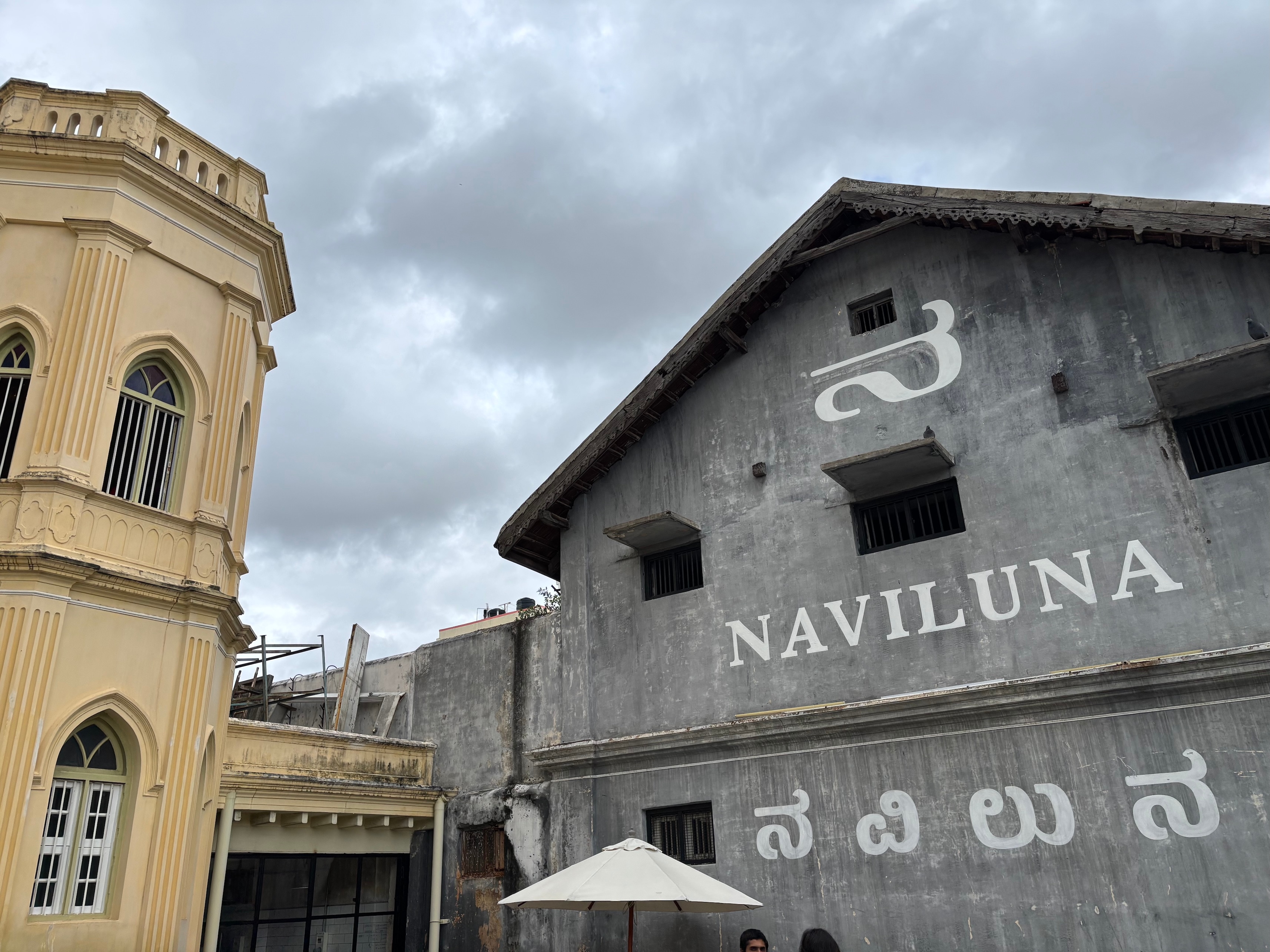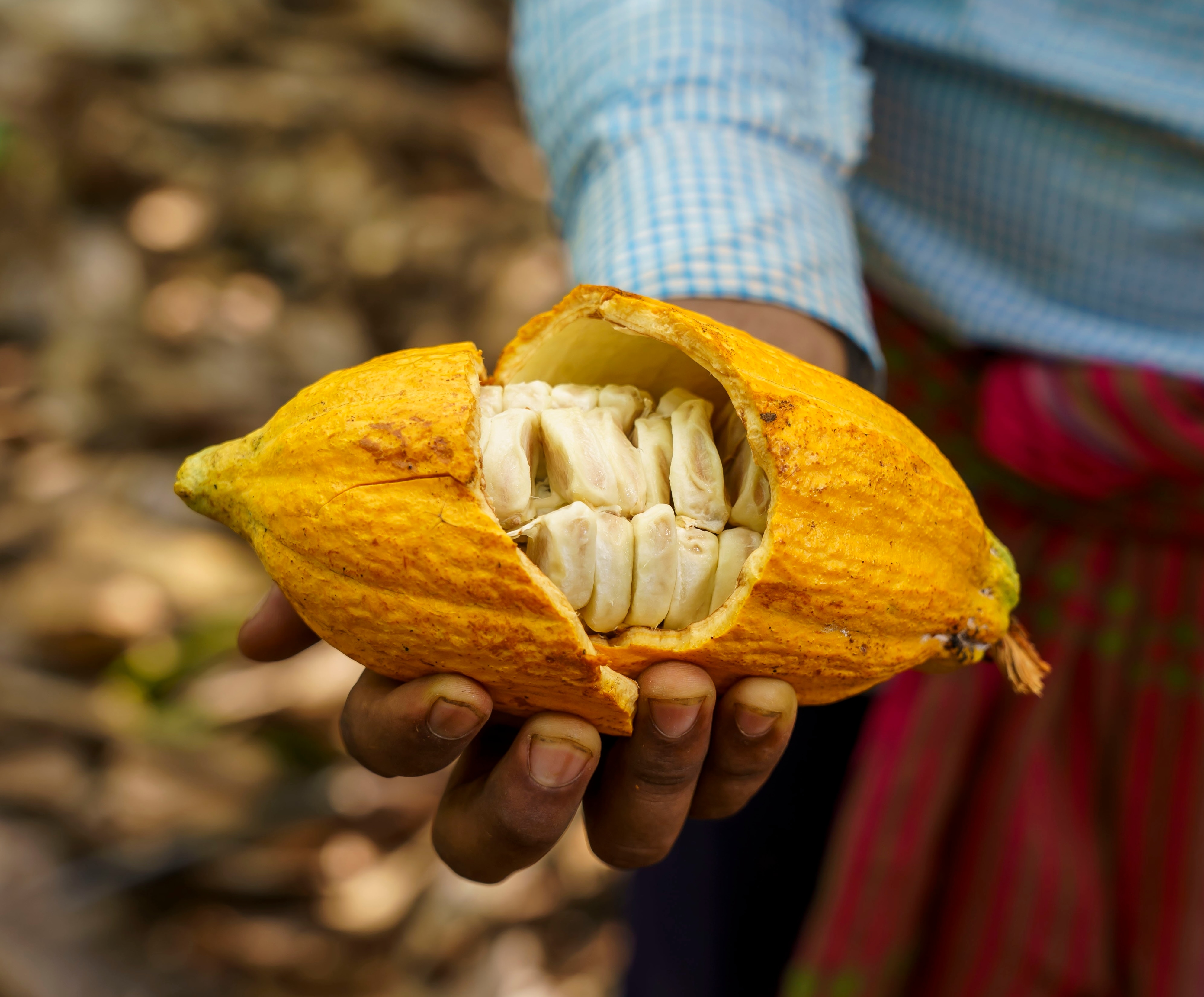Molten couverture chocolate (high-quality chocolate rich in cocoa butter) flows through rows of overhead pipes, pastry chefs temper chocolate live behind glass walls, and impressionist-style artwork dots the sleek interiors, depicting farmers in the lush Theobroma cacao plantations of West Godavari, Andhra Pradesh, from where Manam Chocolate sources its beans.
There’s a chocolate beverage bar, a cafe and a make-your-own-tablet station, while footage from Manam Chocolate’s factory and headquarters in Hyderabad streams across wall-mounted screens. Shelves are stacked with dozens of varieties of single-origin couverture chocolate bars with varying cacao content, dark to white, colourful bonbons, and all manner of pastries. A “Manam classroom” hosts chocolate-tasting and flavour-profiling workshops.
The word Manam—meaning “us” in Telugu—is engraved across the ceiling in multiple regional scripts. The message is clear: this is India’s craft chocolate moment.
Manam Chocolate is part of a growing wave of artisanal chocolate makers in India—alongside brands such as Paul and Mike, Bon Fiction, Naviluna, Cocoacraft, Soklet, The Whole Truth, Darkins, and Mason & Co, that are building a market for premium Indian chocolate. These homegrown brands are emerging as luxury indulgences, while challenging the long-held dominance of foreign brands, including Lindt, Ferrero, Hershey’s and Cadbury.
Backed by sharp branding and origin-led storytelling, these labels work with locally sourced Indian cacao, and small-batch, artisanal methods to highlight the bean’s natural flavour—steering clear of vanilla, artificial additives, or excessive refined sugar common in mainstream chocolate. Characterized by a high cocoa butter content (minimum 31%), these are chocolates with a distinctive sheen, a clean snap, a smooth texture, and a pronounced flavour.
View Full Image
According to Mordor Intelligence, India’s chocolate market is projected to grow from $2.48 billion in 2025 to $3.58 billion by 2030, at a CAGR of 7.63%. With a significant shift toward premium and health-conscious consumption, 44% of Indians in 2022 were willing to pay more for healthier chocolate options—driven in part by rising diabetes rates, which reached 101 million in 2023. In response, manufacturers are launching sugar-free, cane sugar/date-sweetened, organic, and high-cocoa dark chocolate products.
Despite India’s limited cacao output, premium Indian chocolate brands are tapping into the domestic supply and actively working to boost local production and improve farming conditions to produce better quality beans. Sourcing directly from farmers in Andhra Pradesh, Kerala, Tamil Nadu, and Karnataka, while investing in improved fermentation and drying practices, many of the brands are paying top rates for quality beans, while encouraging farmers to treat cacao as a high-value crop.
Before the bean
For Chaitanya Muppala, founder of Manam Chocolate, the journey into craft chocolate began in 2018. “At Almond House—the premium sweets business my father started—a quarter of our revenue came from gifting. Customers began asking: What about chocolate? I had no idea about it,” he recalls. “We started digging deep and discovered the global bean-to-bar movement. That led us to ask two questions: How is chocolate made on an industrial scale? And what goes into small-batch, artisanal chocolate? The process unearthed a lot for us.”

View Full Image
Muppala realised the barriers to entry were low, with many chocolate makers investing in a basic idli batter grinder to churn the beans. Moreover, India’s cacao had—and still does, to an extent—a relatively poor reputation, perceived as being too acidic and gritty compared to beans from other countries.
“It goes back to how cacao came to India, in the early 1960s, brought in by industrial players, the same brands we all grew up eating. They introduced industrial-grade genetics tailored for mass production, focusing on cacao beans valued for their fat content, not their flavour. The flavour is induced through processing and additives,” says Muppala.
Craft chocolate, by contrast, starts with finding—or developing—a great bean, and then applying techniques that preserve and highlight its natural complexity and flavor. So, Muppala went to the farms of West Godavari, the largest cacao-growing region in the country, where over 40% of India’s crop comes from, and tied up with over 150 farmers.
While changing the genetics of the bean is a long-term project, Muppala realised the existing beans can be elevated with more sophisticated processing. Manam Chocolate built its own fermentary to have control over the post-harvesting process.
The company applies its own engineering sensibilities and proprietary technology to compensate for the lack of fine-flavour genetics in Indian cacao with evolved post-harvest processing.
The brand opened its plush headquarters in Hyderabad, the Karkhana, in 2023.
Reframing chocolate
With artisanal chocolate, the draw is not just the fine flavours extracted as close to the bean as possible—where a bar made from Kerala-sourced cacao tastes distinctly different from one made with beans from Andhra Pradesh—it is also the experience.
In Mysuru’s heritage-lined streets, a charming 150-year-old restored bungalow is home to Naviluna, a single-origin Indian chocolate brand known for its distinct flavour combinations—Tokai Coffee and pineapple, Longum pepper, lime and orange, and Três Bāḷe, which features three local varieties of banana.

View Full Image
Adjacent to the bungalow, the chocolate factory operates in full swing, churning out a fresh batch of single-origin Kerala dark couverture, which will later be tempered in the processing room next door, moulded into bars and cooled at just the right temperature to be neatly packed in handmade paper with original artwork.
Upstairs, an atmospheric brasserie serves a menu of chocolate-infused dishes. “The idea is to demonstrate how our chocolate can be used as an ingredient in a larger gastronomic context,” says Naviluna’s founder, David Belo, one of the early movers in the Indian craft chocolate scene, starting the brand as Earthloaf in 2012.
“I saw a clear gap in the market. The 19th- and 20th-century brands of chocolate, like Hershey’s and Cadbury, pushed chocolate as kid-friendly. This was a deviation from its earlier avatar in the courts of Europe, where it was considered something of an aphrodisiac. That’s the space we’re trying to occupy—affordable luxury, very adult-centric, while being fun and playful, and rooted in Mysuru and South Indian culture,” says Belo.
“A lot of people think Naviluna is trying to occupy the Ferrero Rocher or Lindt space. We’re not. We’re trying to be the Macallan whiskey of craft chocolate. We want to reframe chocolate.”
Changing tastes
What’s fuelling this trend is indeed a shift in consumer preferences. “People increasingly want to buy ‘Made in India’ products,” says Vikas Temani, founder of Paul and Mike, headquartered in Kochi.
His brand has found popularity reinventing classics such as hazelnut chocolate, while also building a range around local produce and spices, including jamun, sitaphal and regional coffee, and tapping into global trends like the pistachio-filled “Dubai chocolate”.

View Full Image
“Homegrown cheese, wine, and ice cream brands that have challenged multinationals have opened up opportunities for chocolate makers, too,” he says.
Studying advanced cacao farming in regions like Thailand and Latin America, he found that more than the origin, it’s about having control over processing. “It’s in the flavour profiling—which is all about fermentation, drying, roasting, and grinding done just right,” he says. Another major shift is the role of social media—it has made discovery easier and allowed smaller brands to tell their stories, he adds.
“We have the perfect storm: upwardly mobile, aspirational, well-travelled Indians, searching for experiences they can call their own. And unlike other specialty or craft movements like coffee or wine—which happened elsewhere and we only mimicked later—craft chocolate is so nascent globally that India actually has a chance to lead,” says Muppala.
Beyond personal consumption, craft chocolate has become popular in metro cities as a premium gifting option, including at elite weddings and family gatherings. Many of these chocolate brands are tapping into this segment: Manam Chocolate’s catalogue, for example, features over 350 products—including snacking, drinking, gifting, and indulgence collections—and are presented in premium, artfully designed packaging.
Other than gifting, consumers are drawn to fine chocolate as part of their fitness routines, observes retired navy officer C.T. Kuruvilla, owner of Cocoacraft, a family-run, Kochi-based fine chocolate brand.
“Doctors are recommending it, too, so dark chocolate consumption has grown. Indian brands, in fact, have an edge over companies like Lindt and Ferrero, as our production costs are much lower”, he says. “There are incentives now, like free saplings, so more farmers are taking up cacao cultivation. With 50% year-on-year growth, we now sell to the US and the UK via Amazon. We’re reinvesting into the business and expanding into new markets.”
Newer markets
Another artisanal Indian label going international is tree-to-bar brand Bon Fiction, bootstrapped and founded by engineers Akhil Grandhi and his wife, Prathina. Armed with a chocolate-tasting certification, the couple launched Bon Fiction in 2022.

View Full Image
Growing up amid the vibrant plantations of Rajahmundry in Andhra Pradesh, Grandhi had early exposure to cacao farms. After three years of experimentation and 300 trials, they crafted 14 flavours, including The Mango Menace, with 55% dark chocolate, alphonso and chilli, and Matcha Prince and the Blue Pea, which contains 35.2% white chocolate with blue pea tea and blueberries.
Grandhi says he gradually transitioned consumers into darker types of chocolates, such as their bar Order of the Dark Roast, with 91% Dark Chocolate, to build a palate for it. “We’ve found an audience in the US and the UK. We took Indian ingredients as inspiration and turned them into a global product—like our cranberry and chilli chocolate,” says Grandhi.
“It took time to break even, but we found buyers and were able to export through third-party sellers. People are surprised that India makes chocolate, and that it’s as good as any premium brand there. Currently, 10% of our sales come from foreign markets,” he adds.
Meanwhile at Manam Chocolate, in what may be a first, the brand has signed a deal with a major Swiss chocolate company to explore sourcing Indian cacao in significant volumes—enabling the Swiss brand to produce a single-origin India bar.
Evolving ecosystem
In the past five years, India’s cacao ecosystem has expanded rapidly. “Even small-scale chocolate businesses can be started with an investment of ₹10–20 lakh,” says Paul and Mike’s Temani. “But if you’re aiming for global quality standards, you would need to invest ₹2–3 crore, particularly on the right equipment—most of which comes from Germany, Brazil, China, and parts of Europe.”
The brands follow different funding models. Naviluna, for example, is funded by angel investors and is roping in more to expand its business to metro cities. Manam Chocolate is self-funded by its parent company, Distinct Origins Pvt Ltd, and closed a pre-series A of $3.5 million from marquee investors early this year. Paul and Mike is backed by its parent company, Synthite, a natural food ingredients business.
While most of these brands are already profitable, doubling their business year on year, the founders acknowledge it is a capital-intensive industry and in the current phase of growth, much of the revenue is reinvested back into the business.
If you’re aiming for global quality standards, you would need to invest ₹2–3 crore, particularly on the right equipment.
— Vikas Temani
Even as supply chains and quality beans evolve, a sense of community is growing. Many of India’s new-age chocolate makers are finding visibility through spaces such as the Indian Cacao & Craft Chocolate Festival, co-founded by Bengaluru-based chocolate connoisseur Patricia Cosma. “I believe Indian cacao has so much to offer in terms of flavour—often more fruity, bright, sharp and expressive than even South American beans. Every chocolate factory I have visited in India has its own personality and vibe,” she says.
What began as intimate chocolate-pairing sessions evolved into a full-scale festival that debuted in Bengaluru three years ago and has since showcased over 15 brands from across the country.
Indian cacao, says Cosma, stands out for being hybrid and genetically diverse. “On a single farm, you can find trees that produce entirely different flavour profiles. That’s the beauty of Indian craft chocolate: each batch and season brings something new. It reflects the diversity of India itself.”

View Full Image
Indian craft chocolate is making its way into patisseries and restaurants as well. “It naturally aligns with what I wanted to do— to source ingredients locally. The idea that we had to use imported brands just didn’t make sense anymore,” says Aarohi Sanghavi, founder of Mäki Pâtisserie in Bengaluru, who has worked with several artisanal brands for confections like éclairs, cakes, and ganache. “Each brand brings something different to the table. There can be mild inconsistencies at times, but the beauty of working directly with Indian craft chocolate makers is that we can talk to them, troubleshoot, and adapt.”
Many are glad to have stepped out of the shadow of international chocolate makers. Says Ruby Islam, head chef at Manam Chocolate: “It’s really about us owning our own chocolate.”
Key Takeaways
- There is a growing wave of craft chocolate makers in India.
- Characterized by high cocoa butter content, these chocolates have a distinctive sheen, a smooth texture, and a pronounced flavour.
- Unlike other specialty movements from elsewhere, like coffee or wine, craft chocolate is nascent globally, giving Indian companies a chance to lead the way.
- Beyond personal consumption, craft chocolate has become popular in metro cities as a premium gifting option, including at elite weddings and family gatherings.
- According to Mordor Intelligence, India’s chocolate market is projected to grow from $2.48 billion in 2025 to $3.58 billion by 2030, at a CAGR of 7.63%.
Indian craft chocolate,artisanal chocolate India,Manam Chocolate,paul and mike,Naviluna chocolate,Indian chocolate brands,bean to bar chocolate India,single origin chocolate,Indian cacao,premium chocolate India,dark chocolate India,dark chocolate,best chocolate in India,couverture chocolate,Indian chocolate market,chocolate gifting India,made in India chocolate,Indian chocolate exports,chocolate exports,homegrown chocolate brands,gourmet chocolate India,hocolate startups India,Lindt chocolate India,Cadbury India,Ferrero Rocher India,hershey india,Swiss chocolate,Belgian chocolate,foreign chocolate brands,global chocolate brands,fine chocolate India,Indian luxury chocolate,lindt,cadbury chocolates,cadbury,chocolate makers,manam hyderabad
#Indias #craft #chocolate #revolution #bite #Lindt #Cadbury

